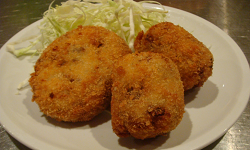Croquettes and Panko
 Gail Umehara / Wordsmith
Gail Umehara / Wordsmith
During her 16 years in Japan, Gail juggled raising a family with, amongst other things, working as a translation assistant, librarian, and editor. Back in Australia, she continues to work with words as an interpreter, editor and TAFE lecturer.
Croquettes and Panko
 A few things you might not know about panko
A few things you might not know about panko
Bread was introduced to Japan in 1543 by the Portuguese, but food coated with breadcrumbs did not appear until much later. Wiener schnitzel began to be served to cadets at Japan's military academies during the Meiji period in the belief that the Western diet had contributed to Prussia's military successes. Whether the result of the 1904-05 Russo-Japanese war influenced the growing appreciation of Western food or not, the evolution of the European schnitzel into the Japanese pork tonkatsu cutlet (said to have been named by Shinjuku restaurateur, Matsuzo Kisano, around 1921) and its popularity with housewives inspired Japanese bread manufacturers to develop their own processes for producing breadcrumbs. Some commercially-produced panko is made from bread "baked" by electroconduction so that there are no crusts; another process involves a centrifuge spinning bread dough into slivers that are blow dried. Whatever the process, 'panko' has come to signify a superior breadcrumb around the world.
Who invented croquettes Is there an "official" shape or filling
"Croquette" is a French word ('croquer' means "to crunch" and a croquette is something crunchy to eat), and the French get culinary recognition for inventing both the potato-based(コロッケ)and the roux-based (クリームコロッケ) versions, though Dutch people firmly believe the roux-based "kroket" was invented in Dutch homes to use up left over stew. The earliest records mention fillings of finely chopped meat, then later fish and vegetable recipes appear. The standard shape in Europe is a cylinder or cone, but in America croquettes are more commonly a flatter patty, commonly referred to as "cake". It seems that cream croquettes are considered to be more of a gourmet item, while potato-based croquettes tend more towards being a snack, with home-made ones often following the Dutch idea of a good way to use up leftover meat and vegetables.

